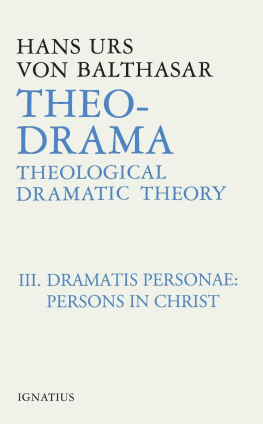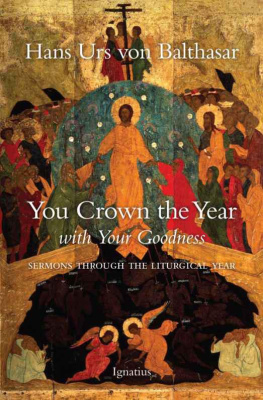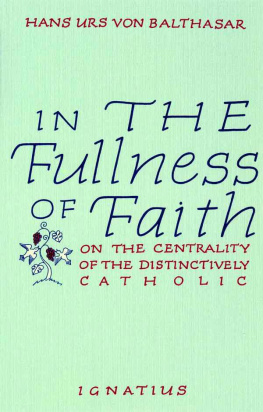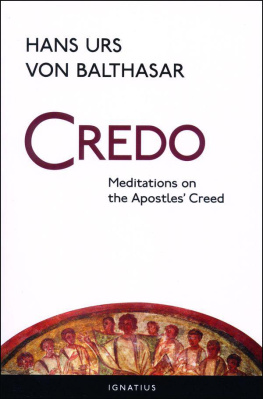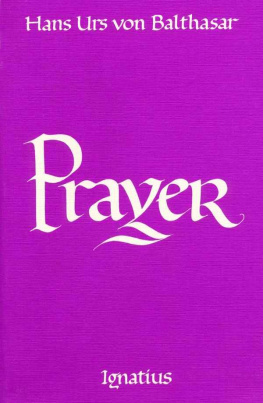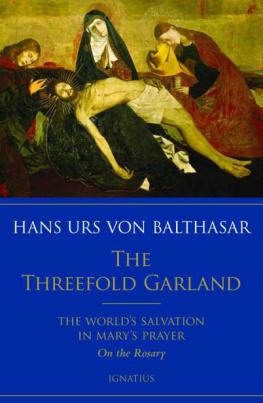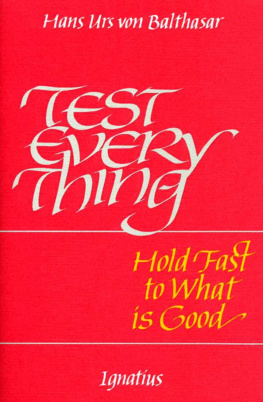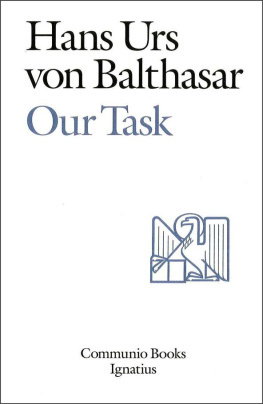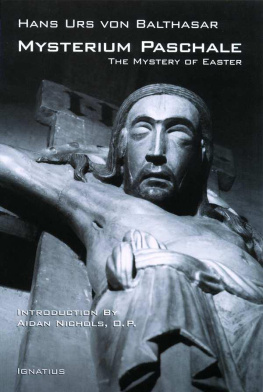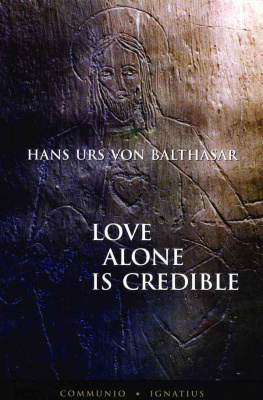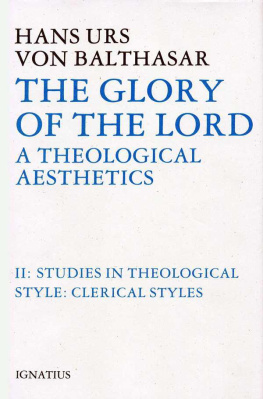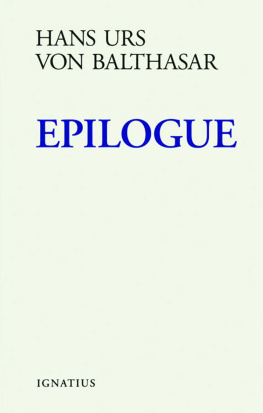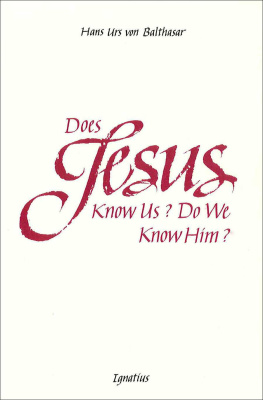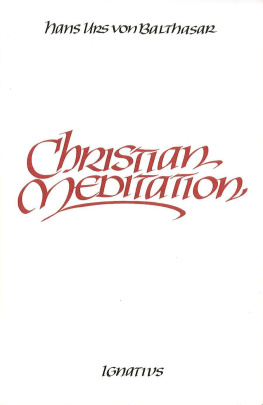THEO-DRAMA
Volume III
THEO-DRAMA
Volumes of the Complete Work:
I: Prolegomena
II: The Dramatis Personae: Man in God
III: The Dramatis Personae: The Person in Christ
IV: The Action
V: The Last Act
HANS URS VON BALTHASAR
THEO-DRAMA
THEOLOGICAL
DRAMATIC THEORY
VOLUME III
THE DRAMATIS PERSONAE:
THE PERSON IN CHRIST
Translated by Graham Harrison
IGNATIUS PRESS SAN FRANCISCO
Title of the German original:
Theodramatik: Zweiter Band: Die Personen des Spiels
Teil 2: Die Personen in Christus
1978 Johannes Verlag, Einsiedeln
With ecclesiastical approval
Cover by Roxanne Mei Lum
1992 Ignatius Press, San Francisco
All rights reserved
ISBN 978-0-89870-295-8
Library of Congress catalogue number 88-80725
Printed in the United States of America
CONTENTS
DRAMATIS PERSONAE (II)
a. The Total Impact of the Personality
b. Continuity in Discontinuity
c. The Provocation of Apocalyptic
a. Inadequate Solutions
b. Eschatology and Dogmatics
c. Drama Regained
a. Transposition in Terms of Discipleship
b. Transposition through Time
c. Transposition from Jesus Horizon
d. The Plurality of New Testament Theologies
a. Mission According to the New Testament
b. Mission: Being and Becoming
a. An Absolute Consciousness of Mission
b. Jesus God-Consciousness and Its Historical Medium
c. Trinitarian Inversion
d. Mission as the Measure of the Knowledge and Freedom of Jesus
a. The Conscious Subject and the Person
b. The Theological Concept of Person
c. Analogia Entis in Christology
a. Jesus and Human Nature
b. Admirabile Commercium
c. En Christoi
d. Christs Mediatorship in Creation
a. Answer, Face
b. Feminine Creature
c. Wider Implications
a. Mother of Christ, Type of the Church
b. Mother of Believers, Bride of the Lord
c. Distortions and a New Start
a. Between Paradise and the Fallen State
b. Between Old and New Covenant
c. Between Time and Eternity
a. The Church and Christ
b. The Church from Mary
c. The Churchs Inner Dramatic Tension: Bride and Institution
a. Chosen in Abraham
b. Gods Command in the Form of Law and Prophecy
c. The Mystery of Israels Continued Existence
a. The Biblical Perspective
b. The Question of Mediation
c. Coming Near and Conversion
a. Mystery
b. Sacrament
c. Transcendence
d. A Divided Church
a. Community and Mission
b. The Situation of the Witness
Thus the Fathers joy and his banquet of welcome remain incomprehensible both to those who worship Gods wisdom (the Greeks) and to those who worship Gods power (the Jews). Only those who worship the Love of God (the Christians) can understand these things. They understand that the story of the Prodigal Son is a real drama of real love and real freedom and that both the Fathers joy and the Fathers banquet are genuine, just as the sufferings of Father and Son, which preceded their reunion, were genuine. Furthermore, they understand that the story of the Prodigal Son is the history of the whole human race and that the history of the human race is a real drama involving real divine love and real human freedom.
Valentin Thomberg
PREFACE
The present volume makes demands on the readers good will in several respects.
In the first place, it occupies a paradoxical position within this theodramatic theory, since it attempts to present the characters, which are so important for the drama, yet without proceeding to deal with the drama itself, something that can only be done if, in each case, the characters are clearly seen to be characters of the play , that is, if they are inwardly governed and shaped by their dramatic nature and their position in the theological unfolding of world events. At many points this will be self-evident.
Furthermore, in the case of the main characters, we shall be moving in the area of highly complicated theological treatises of which it will be quite impossible to give a full treatment. All we can do in these program notes is to present an outline , a sketch of the characters concerned, just enough to give an idea of their part in the play. Nor is this sketch drawn with a view to its being fleshed out later: what comes afterward will be nothing more than a presentation of the dramatic interplay itself, the theo-drama announced in the overall title of these volumes.
Finally a word on the Christology outlined here. I am not an exegete; I do not aspire to enter into the increasingly subtle discussions conducted in exegetical circlesdiscussions that are practically inaccessible to the layman. All the same, it seemed essential to pose the question of the relationship between exegesis and dogmatics. It is not so important whether or not my attempts at exegesis are regarded as successful, for ultimately this survey proceeds a priori on the basis of the total deposit of New Testament Christology, which is normative as far as the Church is concerned. On this basis, we draw conclusions about the being and the consciousness of Jesus: our view is that he whom God commissioned to reconcile the world to him must have realized the meaning and scope of his task. According to many ex-egetes, there is a very thin thread left linking Jesus awareness of his mission and the fulfillment brought about by the post-Easter events, and even this thread threatens to snap. If this were to happen, we would once again find ourselves in a schizophrenic dichotomy between the Jesus of history and the Jesus of faith.
Hans Urs von Balthasar
DRAMATIS PERSONAE (II)
INTRODUCTION
At the end of the previous volume, there was no question of putting forward some neutral anthropology: the anthropology we presented was structured by analogy with the historical event of Jesus Christ. This showed, right from the start, that it is only possible to produce a full doctrine of man (and hence of the world, which man recapitulates) within the context of an overall Christology. Everything remains abstract if it is not brought back to and explained by the Concretissimum in which it is ultimately rooted; moreover, this accords with the great assertions of the New Testament. This is true not only of individual and collective human persons, who only discover their uniqueness and their interrelatedness within that sphere of action that is Christ, but, according to statements such as I Corinthians 15:24 or Colossians 2:15, it applies analogously also to the extrahuman authorities and powers (whatever they may be) that, in the end-time, find themselves subject to his lordship.
The subtitle of this volume is Persons in Christ: the more precise meaning of this in can be left an open question for the moment. It is clear, however, that what is thus encompassed, even if it possesses freedom, is fundamentally determined by the encompassing reality; and since the latter too, both in its divine and in its human aspect, is free, a dramatic element is already signaled in the relationship between them.
The encompassing reality, the concrete figure of Jesus of Nazareth, is himself man, whereas the human beings he encompasses are in part determined by his being and his destiny. This recalls and gives heightened relevance to the statement made at the beginning of the previous volume, namely, that the characters in theo-drama can only be defined on the basis of the action already under way. In what follows, therefore, there can be no question of retailing the usual textbook approach, which starts from an essentialist Christology that claims to have prior knowledge of Jesus essential nature as the Incarnate Word even before the action begins, only subsequently moving over to a dramatic soteriology (christological doctrine of grace). Nor can we portray the persons in Christ (individually and collectively) in isolation from the encompassing framework, for this is both the ground of their being (and being-thus) and also that which facilitates their acting thus or acting differently. But, we may ask, why go to the trouble of a special description of the dramatis personae rather than move directly to describe the action?
Next page
